CFPBUS003: IT Role in Business Success and Ethical Issues Report
VerifiedAdded on 2022/08/17
|20
|4015
|17
Report
AI Summary
This report analyzes the pivotal role of Information Technology (IT) within the business landscape, specifically using Sainsbury's, a UK-based supermarket chain, as a case study. It delves into how IT drives success, enhances customer experiences, and influences sales. The report also explores ethical and social issues tied to IT implementation, such as omnichannel challenges, smartphone marketing, and security concerns. Furthermore, it identifies and differentiates various networking technologies, including PAN, LAN, and WAN, and discusses the importance of social media in business strategies. Finally, the report outlines the stages of the system development life cycle, providing a comprehensive overview of IT's multifaceted impact on modern business operations. This assignment is designed to provide students with a deep understanding of the subject matter and is available on Desklib, which provides all the necessary AI-based study tools for students.
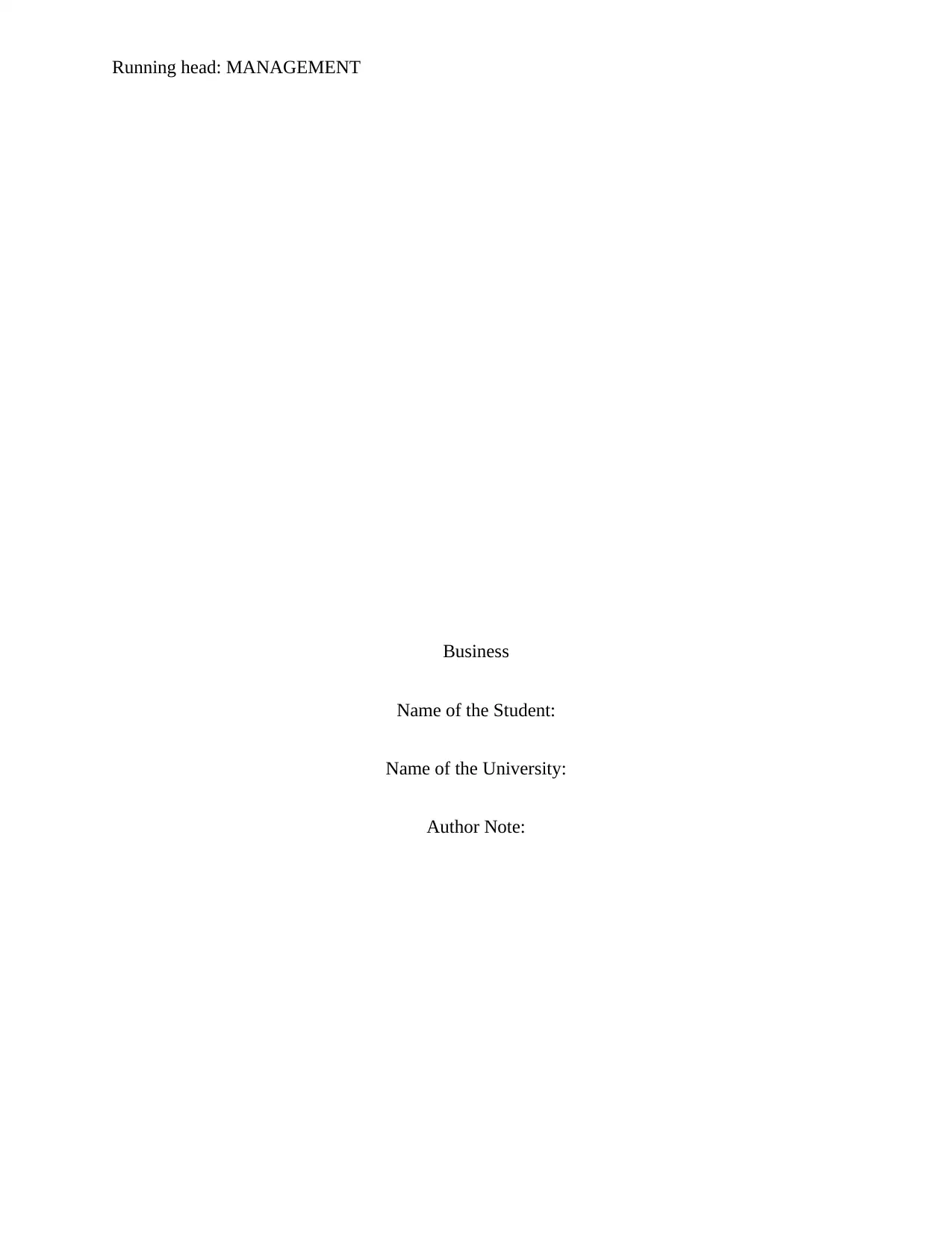
Running head: MANAGEMENT
Business
Name of the Student:
Name of the University:
Author Note:
Business
Name of the Student:
Name of the University:
Author Note:
Paraphrase This Document
Need a fresh take? Get an instant paraphrase of this document with our AI Paraphraser
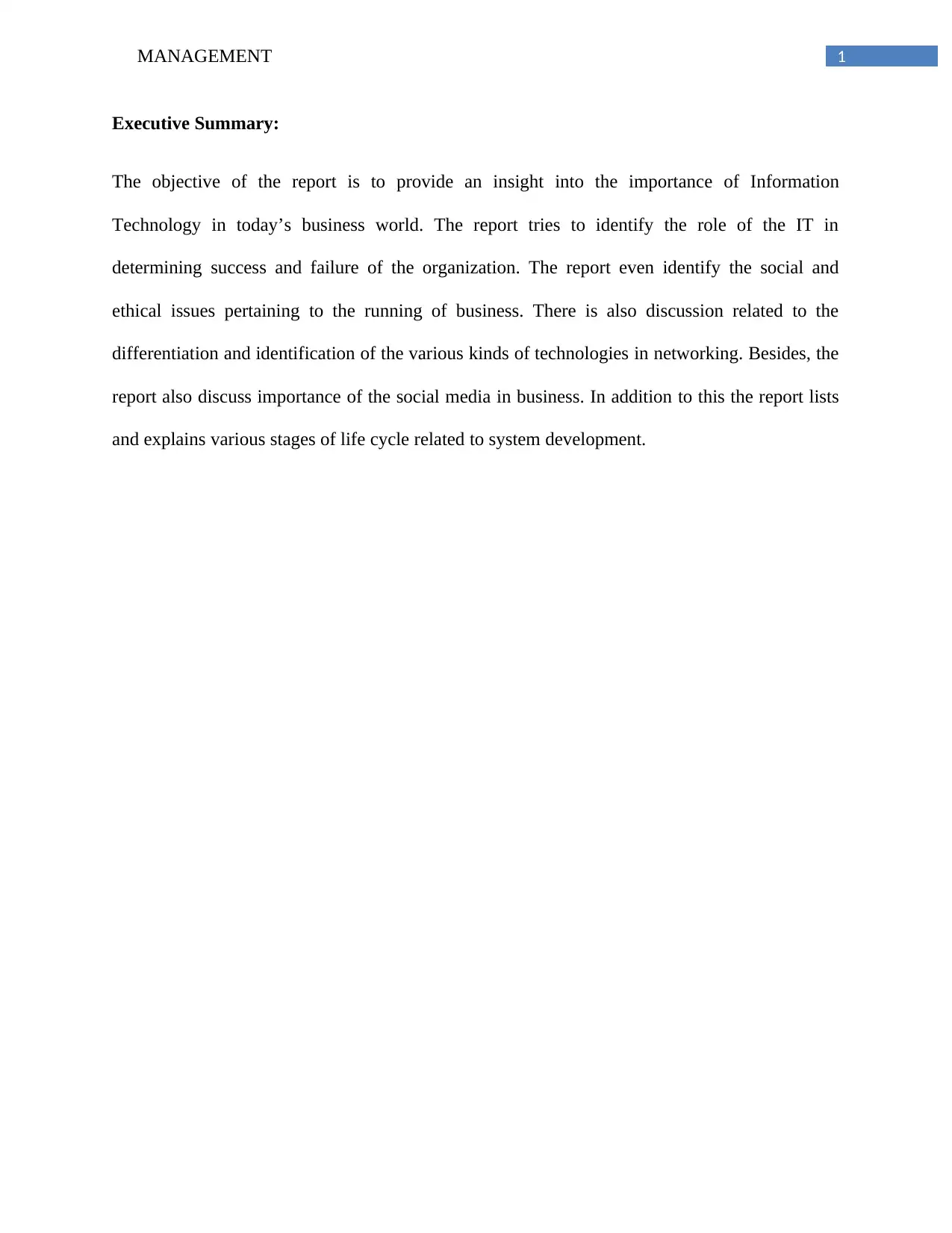
1MANAGEMENT
Executive Summary:
The objective of the report is to provide an insight into the importance of Information
Technology in today’s business world. The report tries to identify the role of the IT in
determining success and failure of the organization. The report even identify the social and
ethical issues pertaining to the running of business. There is also discussion related to the
differentiation and identification of the various kinds of technologies in networking. Besides, the
report also discuss importance of the social media in business. In addition to this the report lists
and explains various stages of life cycle related to system development.
Executive Summary:
The objective of the report is to provide an insight into the importance of Information
Technology in today’s business world. The report tries to identify the role of the IT in
determining success and failure of the organization. The report even identify the social and
ethical issues pertaining to the running of business. There is also discussion related to the
differentiation and identification of the various kinds of technologies in networking. Besides, the
report also discuss importance of the social media in business. In addition to this the report lists
and explains various stages of life cycle related to system development.
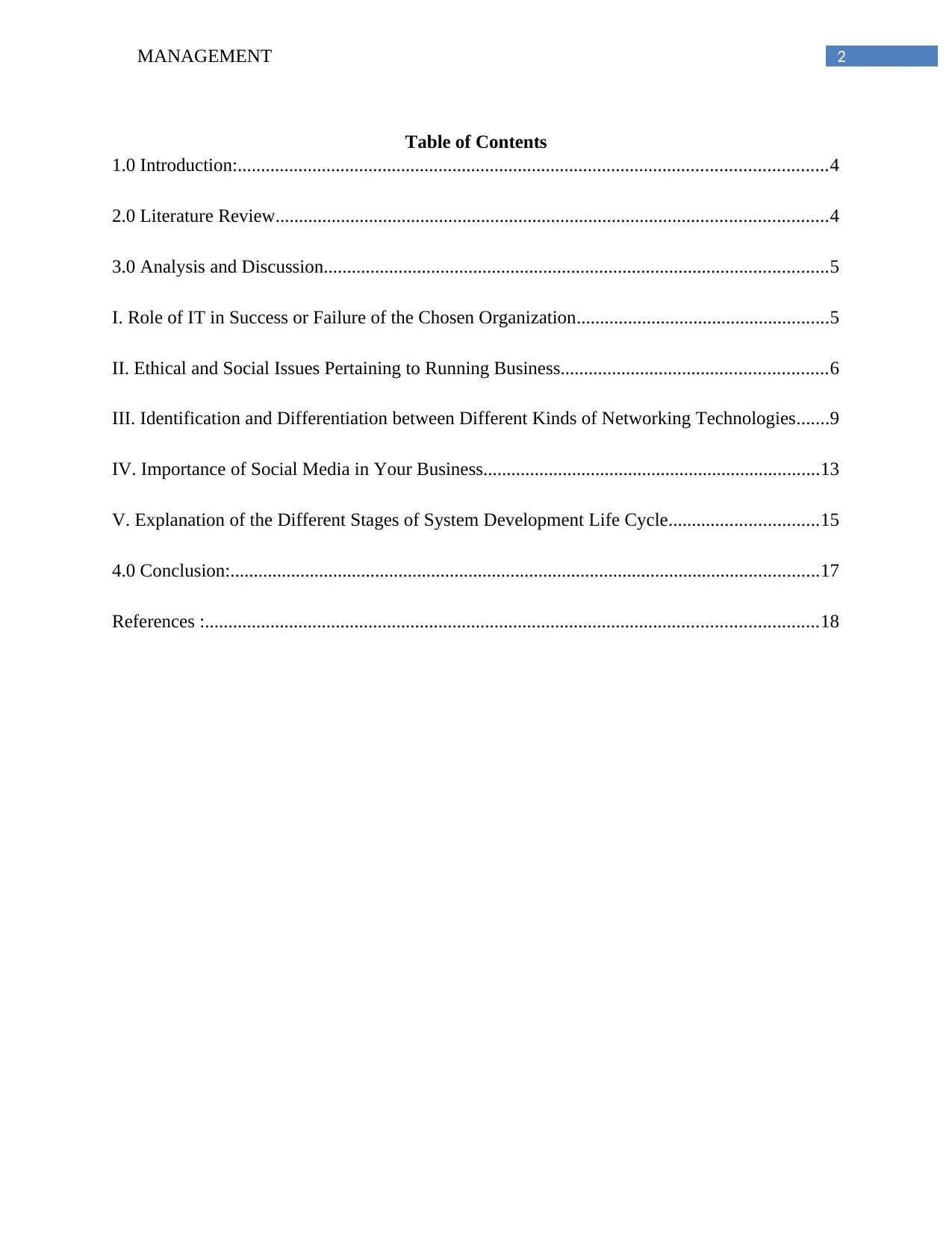
2MANAGEMENT
Table of Contents
1.0 Introduction:..............................................................................................................................4
2.0 Literature Review......................................................................................................................4
3.0 Analysis and Discussion............................................................................................................5
I. Role of IT in Success or Failure of the Chosen Organization......................................................5
II. Ethical and Social Issues Pertaining to Running Business.........................................................6
III. Identification and Differentiation between Different Kinds of Networking Technologies.......9
IV. Importance of Social Media in Your Business........................................................................13
V. Explanation of the Different Stages of System Development Life Cycle................................15
4.0 Conclusion:..............................................................................................................................17
References :...................................................................................................................................18
Table of Contents
1.0 Introduction:..............................................................................................................................4
2.0 Literature Review......................................................................................................................4
3.0 Analysis and Discussion............................................................................................................5
I. Role of IT in Success or Failure of the Chosen Organization......................................................5
II. Ethical and Social Issues Pertaining to Running Business.........................................................6
III. Identification and Differentiation between Different Kinds of Networking Technologies.......9
IV. Importance of Social Media in Your Business........................................................................13
V. Explanation of the Different Stages of System Development Life Cycle................................15
4.0 Conclusion:..............................................................................................................................17
References :...................................................................................................................................18
⊘ This is a preview!⊘
Do you want full access?
Subscribe today to unlock all pages.

Trusted by 1+ million students worldwide
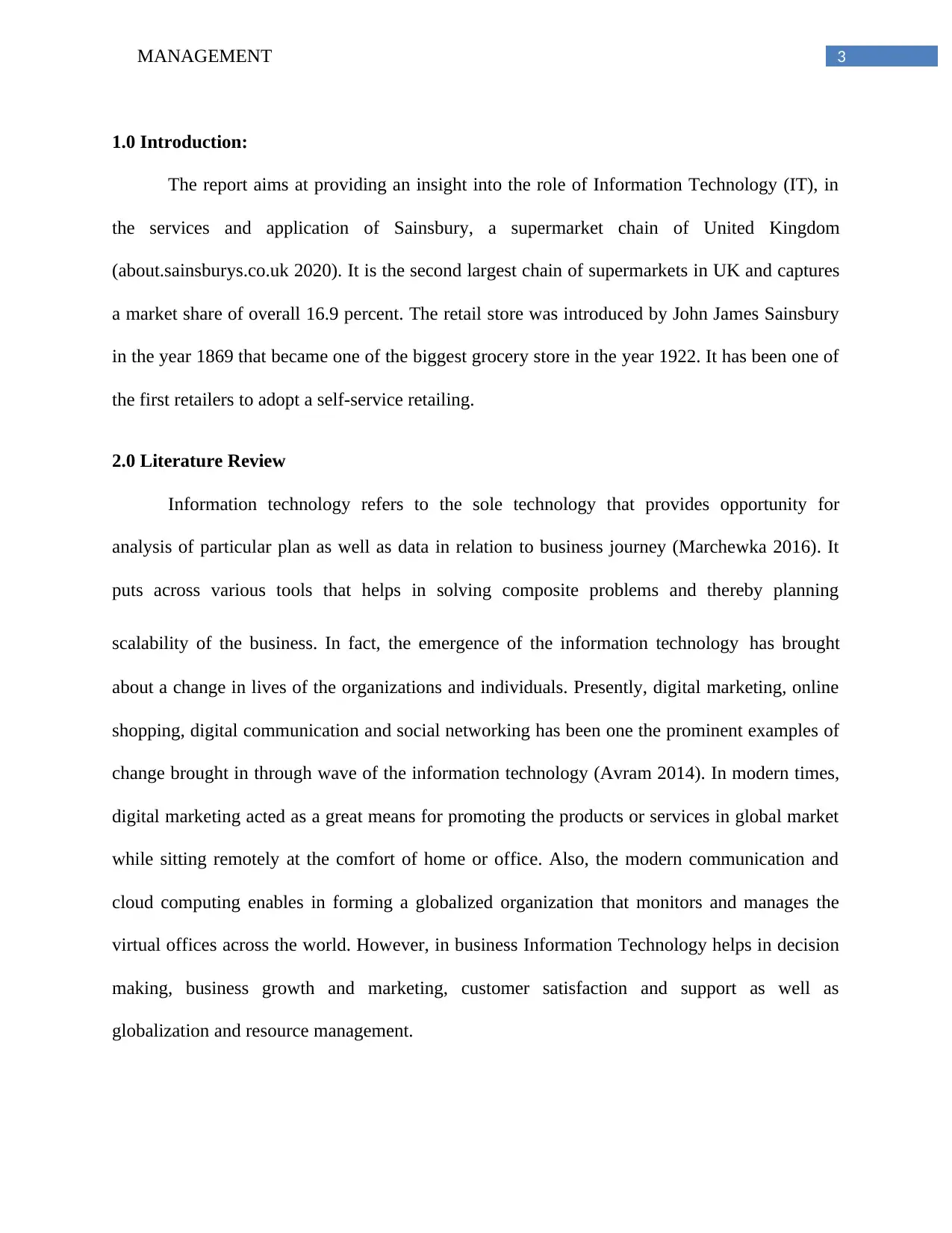
3MANAGEMENT
1.0 Introduction:
The report aims at providing an insight into the role of Information Technology (IT), in
the services and application of Sainsbury, a supermarket chain of United Kingdom
(about.sainsburys.co.uk 2020). It is the second largest chain of supermarkets in UK and captures
a market share of overall 16.9 percent. The retail store was introduced by John James Sainsbury
in the year 1869 that became one of the biggest grocery store in the year 1922. It has been one of
the first retailers to adopt a self-service retailing.
2.0 Literature Review
Information technology refers to the sole technology that provides opportunity for
analysis of particular plan as well as data in relation to business journey (Marchewka 2016). It
puts across various tools that helps in solving composite problems and thereby planning
scalability of the business. In fact, the emergence of the information technology has brought
about a change in lives of the organizations and individuals. Presently, digital marketing, online
shopping, digital communication and social networking has been one the prominent examples of
change brought in through wave of the information technology (Avram 2014). In modern times,
digital marketing acted as a great means for promoting the products or services in global market
while sitting remotely at the comfort of home or office. Also, the modern communication and
cloud computing enables in forming a globalized organization that monitors and manages the
virtual offices across the world. However, in business Information Technology helps in decision
making, business growth and marketing, customer satisfaction and support as well as
globalization and resource management.
1.0 Introduction:
The report aims at providing an insight into the role of Information Technology (IT), in
the services and application of Sainsbury, a supermarket chain of United Kingdom
(about.sainsburys.co.uk 2020). It is the second largest chain of supermarkets in UK and captures
a market share of overall 16.9 percent. The retail store was introduced by John James Sainsbury
in the year 1869 that became one of the biggest grocery store in the year 1922. It has been one of
the first retailers to adopt a self-service retailing.
2.0 Literature Review
Information technology refers to the sole technology that provides opportunity for
analysis of particular plan as well as data in relation to business journey (Marchewka 2016). It
puts across various tools that helps in solving composite problems and thereby planning
scalability of the business. In fact, the emergence of the information technology has brought
about a change in lives of the organizations and individuals. Presently, digital marketing, online
shopping, digital communication and social networking has been one the prominent examples of
change brought in through wave of the information technology (Avram 2014). In modern times,
digital marketing acted as a great means for promoting the products or services in global market
while sitting remotely at the comfort of home or office. Also, the modern communication and
cloud computing enables in forming a globalized organization that monitors and manages the
virtual offices across the world. However, in business Information Technology helps in decision
making, business growth and marketing, customer satisfaction and support as well as
globalization and resource management.
Paraphrase This Document
Need a fresh take? Get an instant paraphrase of this document with our AI Paraphraser
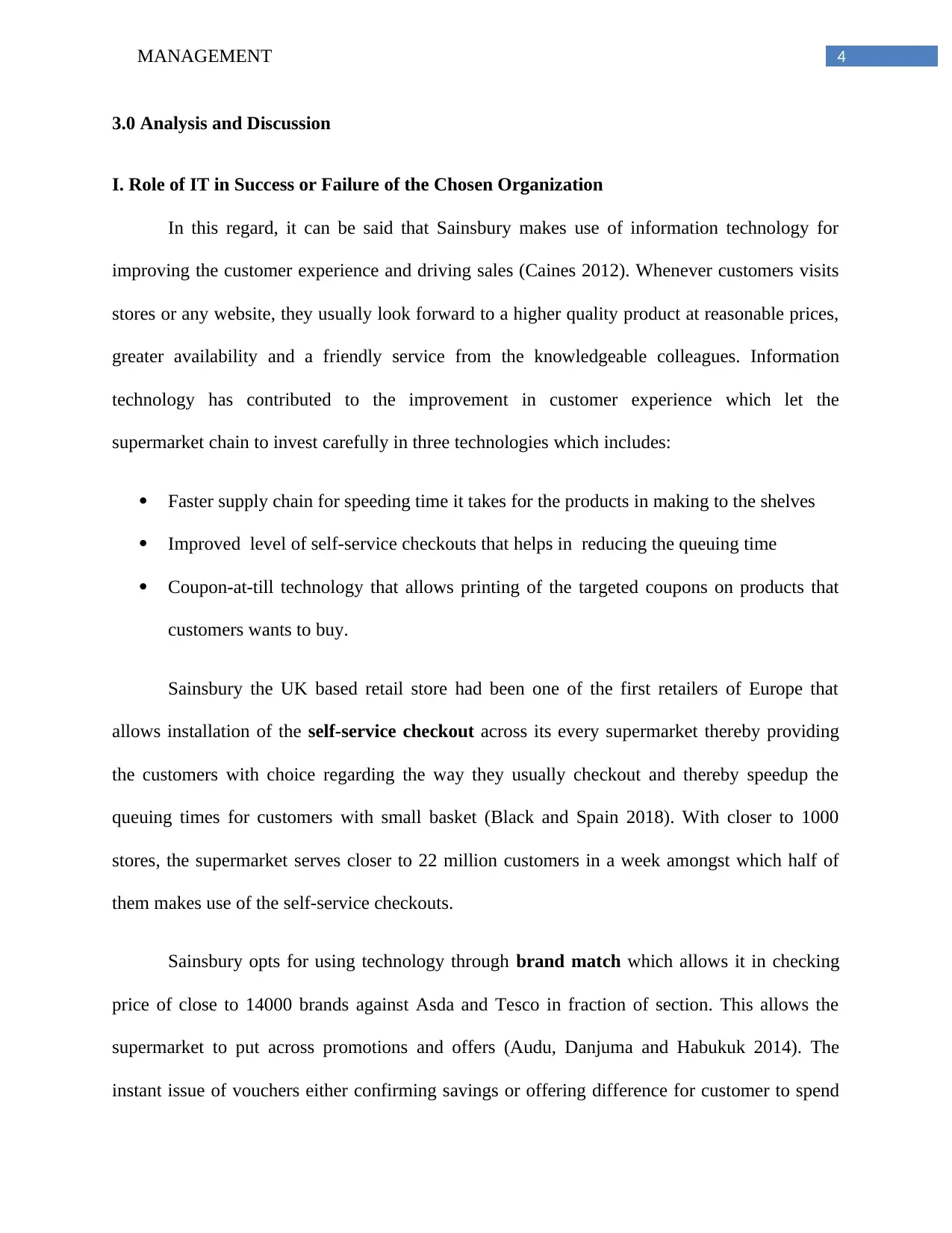
4MANAGEMENT
3.0 Analysis and Discussion
I. Role of IT in Success or Failure of the Chosen Organization
In this regard, it can be said that Sainsbury makes use of information technology for
improving the customer experience and driving sales (Caines 2012). Whenever customers visits
stores or any website, they usually look forward to a higher quality product at reasonable prices,
greater availability and a friendly service from the knowledgeable colleagues. Information
technology has contributed to the improvement in customer experience which let the
supermarket chain to invest carefully in three technologies which includes:
Faster supply chain for speeding time it takes for the products in making to the shelves
Improved level of self-service checkouts that helps in reducing the queuing time
Coupon-at-till technology that allows printing of the targeted coupons on products that
customers wants to buy.
Sainsbury the UK based retail store had been one of the first retailers of Europe that
allows installation of the self-service checkout across its every supermarket thereby providing
the customers with choice regarding the way they usually checkout and thereby speedup the
queuing times for customers with small basket (Black and Spain 2018). With closer to 1000
stores, the supermarket serves closer to 22 million customers in a week amongst which half of
them makes use of the self-service checkouts.
Sainsbury opts for using technology through brand match which allows it in checking
price of close to 14000 brands against Asda and Tesco in fraction of section. This allows the
supermarket to put across promotions and offers (Audu, Danjuma and Habukuk 2014). The
instant issue of vouchers either confirming savings or offering difference for customer to spend
3.0 Analysis and Discussion
I. Role of IT in Success or Failure of the Chosen Organization
In this regard, it can be said that Sainsbury makes use of information technology for
improving the customer experience and driving sales (Caines 2012). Whenever customers visits
stores or any website, they usually look forward to a higher quality product at reasonable prices,
greater availability and a friendly service from the knowledgeable colleagues. Information
technology has contributed to the improvement in customer experience which let the
supermarket chain to invest carefully in three technologies which includes:
Faster supply chain for speeding time it takes for the products in making to the shelves
Improved level of self-service checkouts that helps in reducing the queuing time
Coupon-at-till technology that allows printing of the targeted coupons on products that
customers wants to buy.
Sainsbury the UK based retail store had been one of the first retailers of Europe that
allows installation of the self-service checkout across its every supermarket thereby providing
the customers with choice regarding the way they usually checkout and thereby speedup the
queuing times for customers with small basket (Black and Spain 2018). With closer to 1000
stores, the supermarket serves closer to 22 million customers in a week amongst which half of
them makes use of the self-service checkouts.
Sainsbury opts for using technology through brand match which allows it in checking
price of close to 14000 brands against Asda and Tesco in fraction of section. This allows the
supermarket to put across promotions and offers (Audu, Danjuma and Habukuk 2014). The
instant issue of vouchers either confirming savings or offering difference for customer to spend
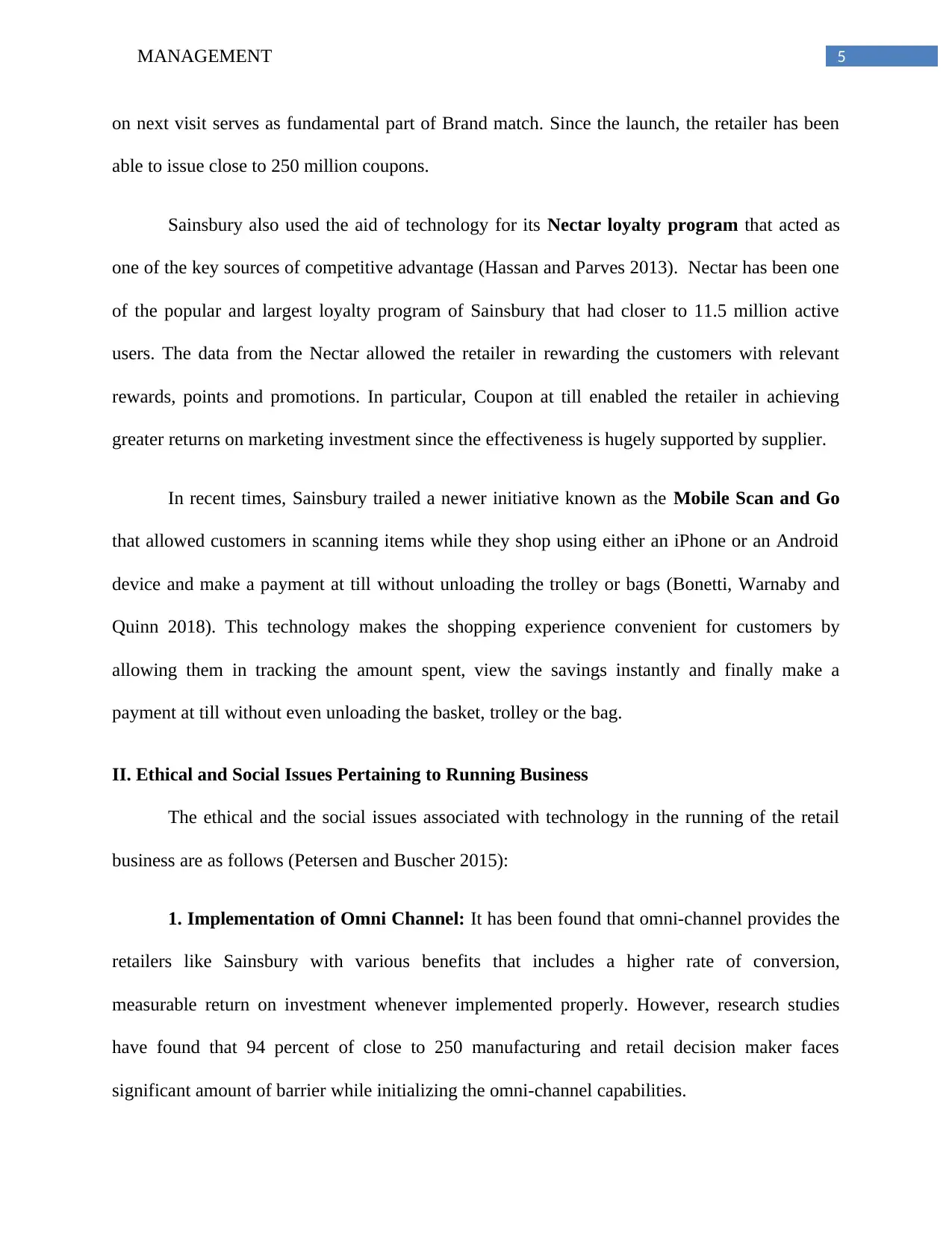
5MANAGEMENT
on next visit serves as fundamental part of Brand match. Since the launch, the retailer has been
able to issue close to 250 million coupons.
Sainsbury also used the aid of technology for its Nectar loyalty program that acted as
one of the key sources of competitive advantage (Hassan and Parves 2013). Nectar has been one
of the popular and largest loyalty program of Sainsbury that had closer to 11.5 million active
users. The data from the Nectar allowed the retailer in rewarding the customers with relevant
rewards, points and promotions. In particular, Coupon at till enabled the retailer in achieving
greater returns on marketing investment since the effectiveness is hugely supported by supplier.
In recent times, Sainsbury trailed a newer initiative known as the Mobile Scan and Go
that allowed customers in scanning items while they shop using either an iPhone or an Android
device and make a payment at till without unloading the trolley or bags (Bonetti, Warnaby and
Quinn 2018). This technology makes the shopping experience convenient for customers by
allowing them in tracking the amount spent, view the savings instantly and finally make a
payment at till without even unloading the basket, trolley or the bag.
II. Ethical and Social Issues Pertaining to Running Business
The ethical and the social issues associated with technology in the running of the retail
business are as follows (Petersen and Buscher 2015):
1. Implementation of Omni Channel: It has been found that omni-channel provides the
retailers like Sainsbury with various benefits that includes a higher rate of conversion,
measurable return on investment whenever implemented properly. However, research studies
have found that 94 percent of close to 250 manufacturing and retail decision maker faces
significant amount of barrier while initializing the omni-channel capabilities.
on next visit serves as fundamental part of Brand match. Since the launch, the retailer has been
able to issue close to 250 million coupons.
Sainsbury also used the aid of technology for its Nectar loyalty program that acted as
one of the key sources of competitive advantage (Hassan and Parves 2013). Nectar has been one
of the popular and largest loyalty program of Sainsbury that had closer to 11.5 million active
users. The data from the Nectar allowed the retailer in rewarding the customers with relevant
rewards, points and promotions. In particular, Coupon at till enabled the retailer in achieving
greater returns on marketing investment since the effectiveness is hugely supported by supplier.
In recent times, Sainsbury trailed a newer initiative known as the Mobile Scan and Go
that allowed customers in scanning items while they shop using either an iPhone or an Android
device and make a payment at till without unloading the trolley or bags (Bonetti, Warnaby and
Quinn 2018). This technology makes the shopping experience convenient for customers by
allowing them in tracking the amount spent, view the savings instantly and finally make a
payment at till without even unloading the basket, trolley or the bag.
II. Ethical and Social Issues Pertaining to Running Business
The ethical and the social issues associated with technology in the running of the retail
business are as follows (Petersen and Buscher 2015):
1. Implementation of Omni Channel: It has been found that omni-channel provides the
retailers like Sainsbury with various benefits that includes a higher rate of conversion,
measurable return on investment whenever implemented properly. However, research studies
have found that 94 percent of close to 250 manufacturing and retail decision maker faces
significant amount of barrier while initializing the omni-channel capabilities.
⊘ This is a preview!⊘
Do you want full access?
Subscribe today to unlock all pages.

Trusted by 1+ million students worldwide
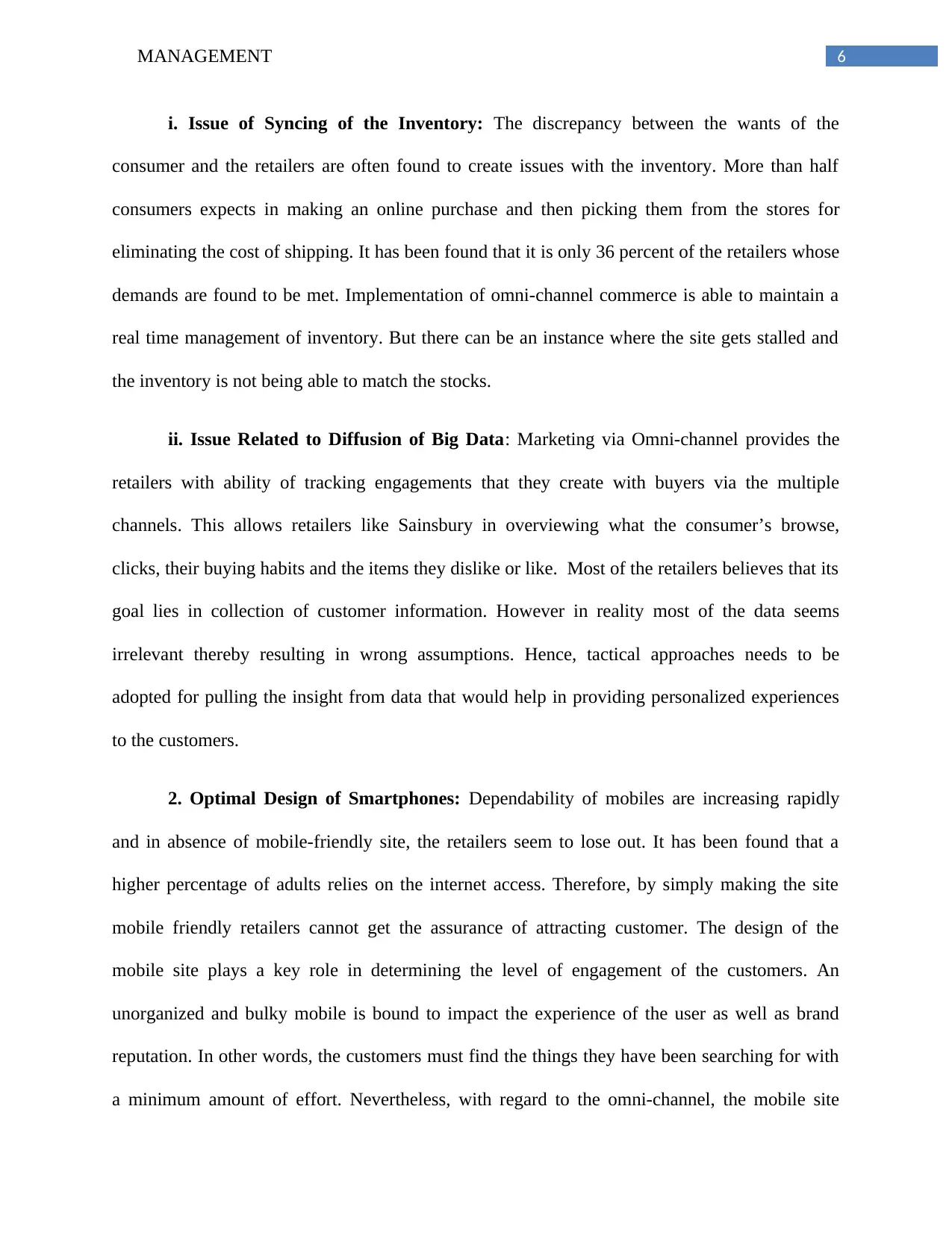
6MANAGEMENT
i. Issue of Syncing of the Inventory: The discrepancy between the wants of the
consumer and the retailers are often found to create issues with the inventory. More than half
consumers expects in making an online purchase and then picking them from the stores for
eliminating the cost of shipping. It has been found that it is only 36 percent of the retailers whose
demands are found to be met. Implementation of omni-channel commerce is able to maintain a
real time management of inventory. But there can be an instance where the site gets stalled and
the inventory is not being able to match the stocks.
ii. Issue Related to Diffusion of Big Data: Marketing via Omni-channel provides the
retailers with ability of tracking engagements that they create with buyers via the multiple
channels. This allows retailers like Sainsbury in overviewing what the consumer’s browse,
clicks, their buying habits and the items they dislike or like. Most of the retailers believes that its
goal lies in collection of customer information. However in reality most of the data seems
irrelevant thereby resulting in wrong assumptions. Hence, tactical approaches needs to be
adopted for pulling the insight from data that would help in providing personalized experiences
to the customers.
2. Optimal Design of Smartphones: Dependability of mobiles are increasing rapidly
and in absence of mobile-friendly site, the retailers seem to lose out. It has been found that a
higher percentage of adults relies on the internet access. Therefore, by simply making the site
mobile friendly retailers cannot get the assurance of attracting customer. The design of the
mobile site plays a key role in determining the level of engagement of the customers. An
unorganized and bulky mobile is bound to impact the experience of the user as well as brand
reputation. In other words, the customers must find the things they have been searching for with
a minimum amount of effort. Nevertheless, with regard to the omni-channel, the mobile site
i. Issue of Syncing of the Inventory: The discrepancy between the wants of the
consumer and the retailers are often found to create issues with the inventory. More than half
consumers expects in making an online purchase and then picking them from the stores for
eliminating the cost of shipping. It has been found that it is only 36 percent of the retailers whose
demands are found to be met. Implementation of omni-channel commerce is able to maintain a
real time management of inventory. But there can be an instance where the site gets stalled and
the inventory is not being able to match the stocks.
ii. Issue Related to Diffusion of Big Data: Marketing via Omni-channel provides the
retailers with ability of tracking engagements that they create with buyers via the multiple
channels. This allows retailers like Sainsbury in overviewing what the consumer’s browse,
clicks, their buying habits and the items they dislike or like. Most of the retailers believes that its
goal lies in collection of customer information. However in reality most of the data seems
irrelevant thereby resulting in wrong assumptions. Hence, tactical approaches needs to be
adopted for pulling the insight from data that would help in providing personalized experiences
to the customers.
2. Optimal Design of Smartphones: Dependability of mobiles are increasing rapidly
and in absence of mobile-friendly site, the retailers seem to lose out. It has been found that a
higher percentage of adults relies on the internet access. Therefore, by simply making the site
mobile friendly retailers cannot get the assurance of attracting customer. The design of the
mobile site plays a key role in determining the level of engagement of the customers. An
unorganized and bulky mobile is bound to impact the experience of the user as well as brand
reputation. In other words, the customers must find the things they have been searching for with
a minimum amount of effort. Nevertheless, with regard to the omni-channel, the mobile site
Paraphrase This Document
Need a fresh take? Get an instant paraphrase of this document with our AI Paraphraser
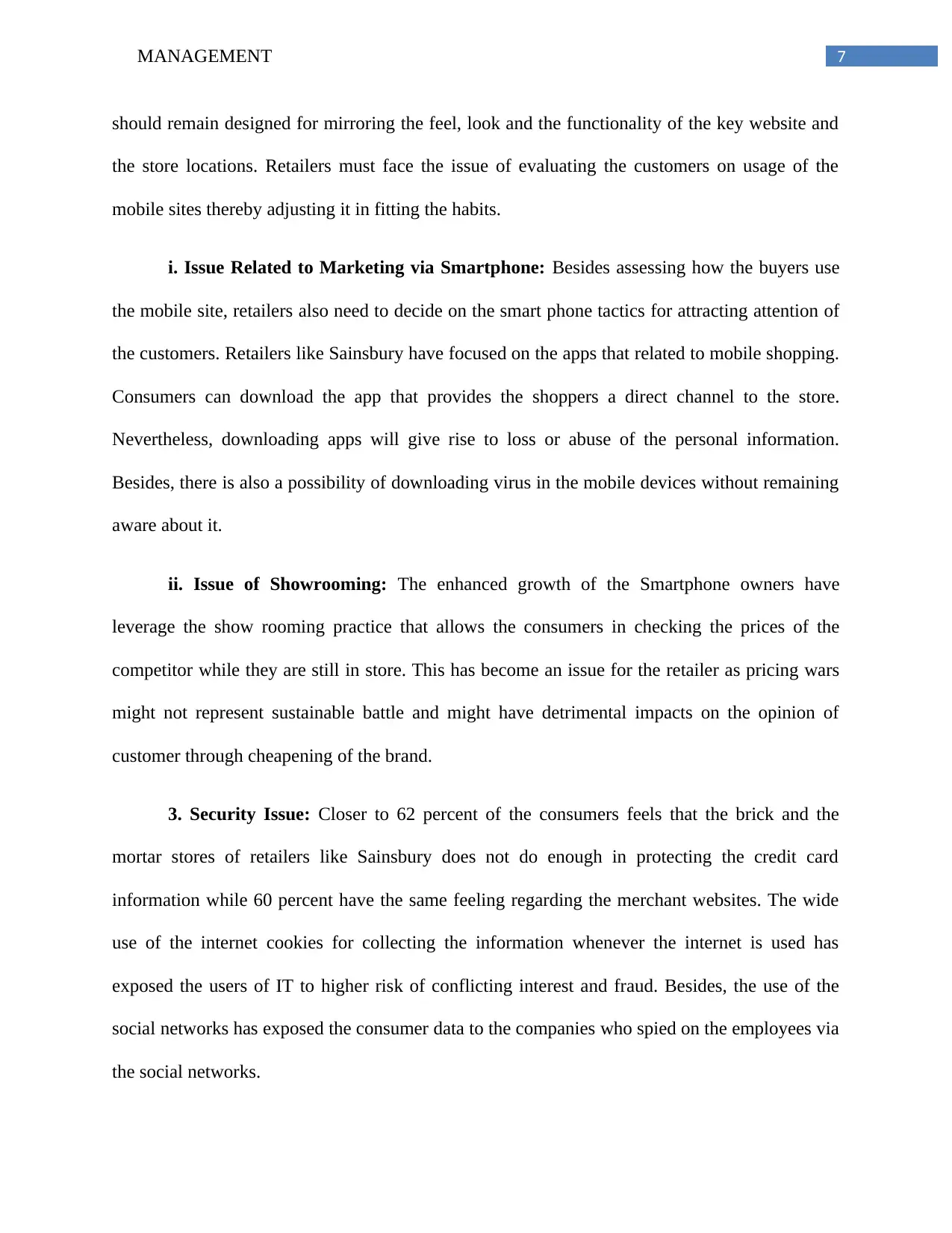
7MANAGEMENT
should remain designed for mirroring the feel, look and the functionality of the key website and
the store locations. Retailers must face the issue of evaluating the customers on usage of the
mobile sites thereby adjusting it in fitting the habits.
i. Issue Related to Marketing via Smartphone: Besides assessing how the buyers use
the mobile site, retailers also need to decide on the smart phone tactics for attracting attention of
the customers. Retailers like Sainsbury have focused on the apps that related to mobile shopping.
Consumers can download the app that provides the shoppers a direct channel to the store.
Nevertheless, downloading apps will give rise to loss or abuse of the personal information.
Besides, there is also a possibility of downloading virus in the mobile devices without remaining
aware about it.
ii. Issue of Showrooming: The enhanced growth of the Smartphone owners have
leverage the show rooming practice that allows the consumers in checking the prices of the
competitor while they are still in store. This has become an issue for the retailer as pricing wars
might not represent sustainable battle and might have detrimental impacts on the opinion of
customer through cheapening of the brand.
3. Security Issue: Closer to 62 percent of the consumers feels that the brick and the
mortar stores of retailers like Sainsbury does not do enough in protecting the credit card
information while 60 percent have the same feeling regarding the merchant websites. The wide
use of the internet cookies for collecting the information whenever the internet is used has
exposed the users of IT to higher risk of conflicting interest and fraud. Besides, the use of the
social networks has exposed the consumer data to the companies who spied on the employees via
the social networks.
should remain designed for mirroring the feel, look and the functionality of the key website and
the store locations. Retailers must face the issue of evaluating the customers on usage of the
mobile sites thereby adjusting it in fitting the habits.
i. Issue Related to Marketing via Smartphone: Besides assessing how the buyers use
the mobile site, retailers also need to decide on the smart phone tactics for attracting attention of
the customers. Retailers like Sainsbury have focused on the apps that related to mobile shopping.
Consumers can download the app that provides the shoppers a direct channel to the store.
Nevertheless, downloading apps will give rise to loss or abuse of the personal information.
Besides, there is also a possibility of downloading virus in the mobile devices without remaining
aware about it.
ii. Issue of Showrooming: The enhanced growth of the Smartphone owners have
leverage the show rooming practice that allows the consumers in checking the prices of the
competitor while they are still in store. This has become an issue for the retailer as pricing wars
might not represent sustainable battle and might have detrimental impacts on the opinion of
customer through cheapening of the brand.
3. Security Issue: Closer to 62 percent of the consumers feels that the brick and the
mortar stores of retailers like Sainsbury does not do enough in protecting the credit card
information while 60 percent have the same feeling regarding the merchant websites. The wide
use of the internet cookies for collecting the information whenever the internet is used has
exposed the users of IT to higher risk of conflicting interest and fraud. Besides, the use of the
social networks has exposed the consumer data to the companies who spied on the employees via
the social networks.
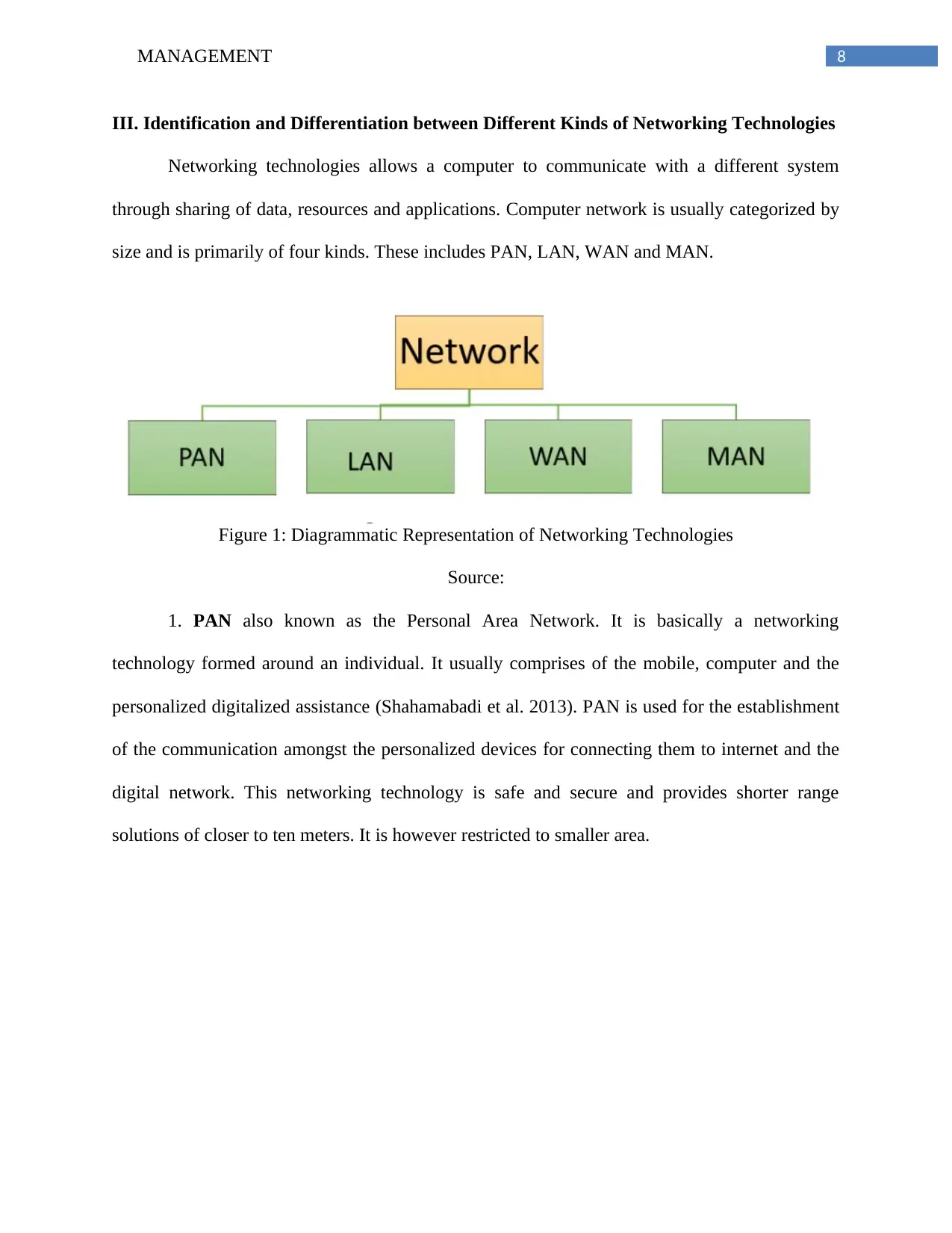
8MANAGEMENT
III. Identification and Differentiation between Different Kinds of Networking Technologies
Networking technologies allows a computer to communicate with a different system
through sharing of data, resources and applications. Computer network is usually categorized by
size and is primarily of four kinds. These includes PAN, LAN, WAN and MAN.
Figure 1: Diagrammatic Representation of Networking Technologies
Source:
1. PAN also known as the Personal Area Network. It is basically a networking
technology formed around an individual. It usually comprises of the mobile, computer and the
personalized digitalized assistance (Shahamabadi et al. 2013). PAN is used for the establishment
of the communication amongst the personalized devices for connecting them to internet and the
digital network. This networking technology is safe and secure and provides shorter range
solutions of closer to ten meters. It is however restricted to smaller area.
III. Identification and Differentiation between Different Kinds of Networking Technologies
Networking technologies allows a computer to communicate with a different system
through sharing of data, resources and applications. Computer network is usually categorized by
size and is primarily of four kinds. These includes PAN, LAN, WAN and MAN.
Figure 1: Diagrammatic Representation of Networking Technologies
Source:
1. PAN also known as the Personal Area Network. It is basically a networking
technology formed around an individual. It usually comprises of the mobile, computer and the
personalized digitalized assistance (Shahamabadi et al. 2013). PAN is used for the establishment
of the communication amongst the personalized devices for connecting them to internet and the
digital network. This networking technology is safe and secure and provides shorter range
solutions of closer to ten meters. It is however restricted to smaller area.
⊘ This is a preview!⊘
Do you want full access?
Subscribe today to unlock all pages.

Trusted by 1+ million students worldwide
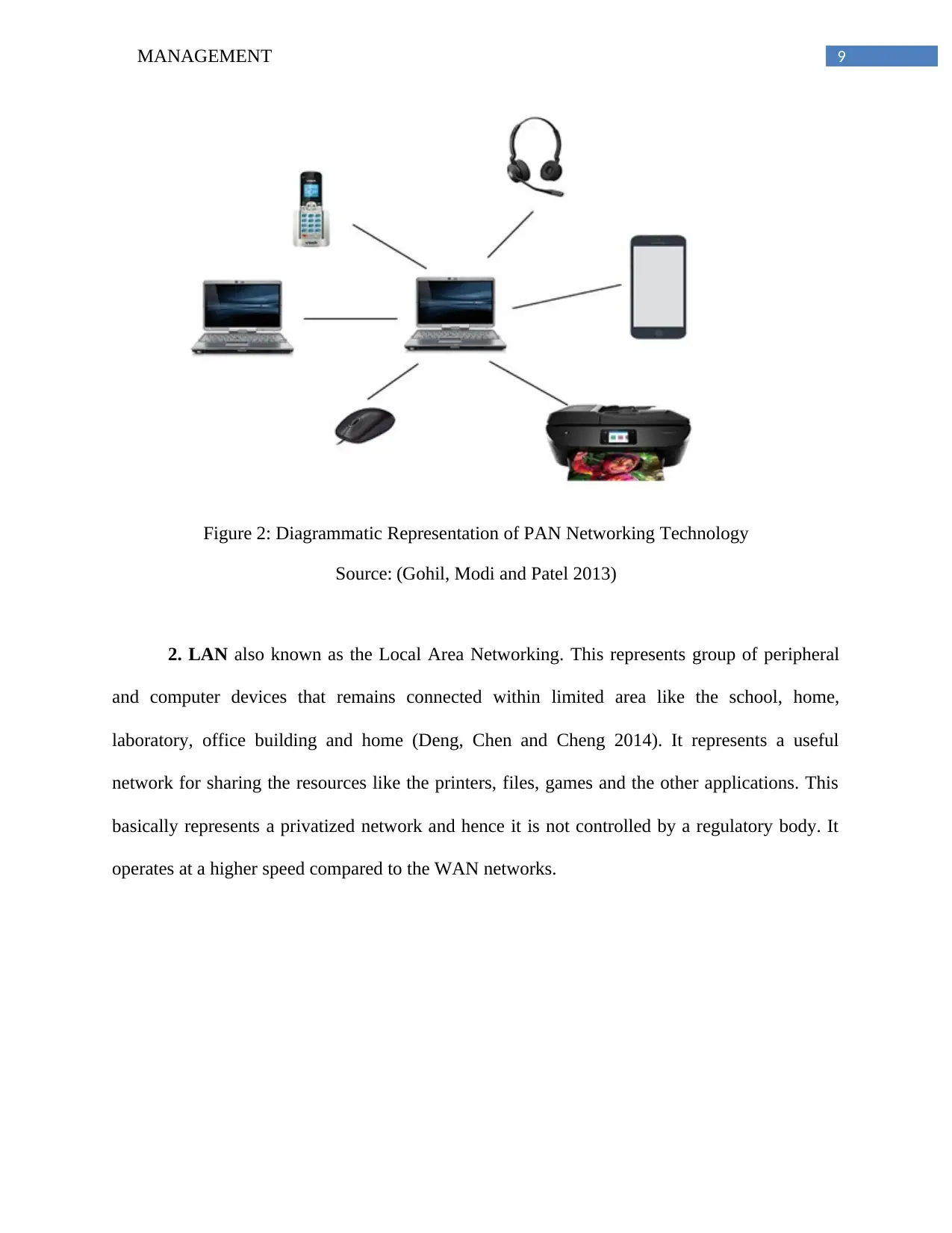
9MANAGEMENT
Figure 2: Diagrammatic Representation of PAN Networking Technology
Source: (Gohil, Modi and Patel 2013)
2. LAN also known as the Local Area Networking. This represents group of peripheral
and computer devices that remains connected within limited area like the school, home,
laboratory, office building and home (Deng, Chen and Cheng 2014). It represents a useful
network for sharing the resources like the printers, files, games and the other applications. This
basically represents a privatized network and hence it is not controlled by a regulatory body. It
operates at a higher speed compared to the WAN networks.
Figure 2: Diagrammatic Representation of PAN Networking Technology
Source: (Gohil, Modi and Patel 2013)
2. LAN also known as the Local Area Networking. This represents group of peripheral
and computer devices that remains connected within limited area like the school, home,
laboratory, office building and home (Deng, Chen and Cheng 2014). It represents a useful
network for sharing the resources like the printers, files, games and the other applications. This
basically represents a privatized network and hence it is not controlled by a regulatory body. It
operates at a higher speed compared to the WAN networks.
Paraphrase This Document
Need a fresh take? Get an instant paraphrase of this document with our AI Paraphraser
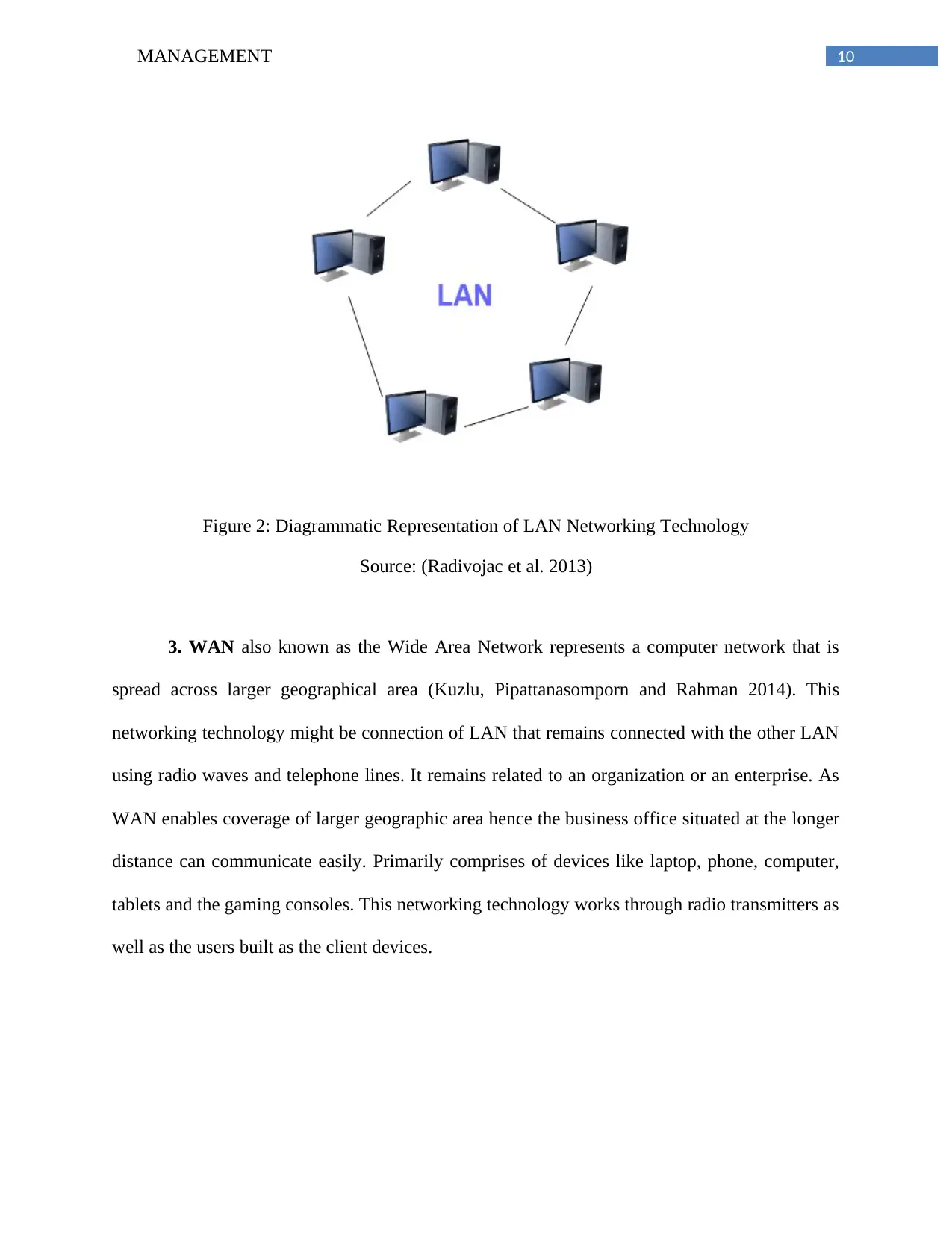
10MANAGEMENT
Figure 2: Diagrammatic Representation of LAN Networking Technology
Source: (Radivojac et al. 2013)
3. WAN also known as the Wide Area Network represents a computer network that is
spread across larger geographical area (Kuzlu, Pipattanasomporn and Rahman 2014). This
networking technology might be connection of LAN that remains connected with the other LAN
using radio waves and telephone lines. It remains related to an organization or an enterprise. As
WAN enables coverage of larger geographic area hence the business office situated at the longer
distance can communicate easily. Primarily comprises of devices like laptop, phone, computer,
tablets and the gaming consoles. This networking technology works through radio transmitters as
well as the users built as the client devices.
Figure 2: Diagrammatic Representation of LAN Networking Technology
Source: (Radivojac et al. 2013)
3. WAN also known as the Wide Area Network represents a computer network that is
spread across larger geographical area (Kuzlu, Pipattanasomporn and Rahman 2014). This
networking technology might be connection of LAN that remains connected with the other LAN
using radio waves and telephone lines. It remains related to an organization or an enterprise. As
WAN enables coverage of larger geographic area hence the business office situated at the longer
distance can communicate easily. Primarily comprises of devices like laptop, phone, computer,
tablets and the gaming consoles. This networking technology works through radio transmitters as
well as the users built as the client devices.
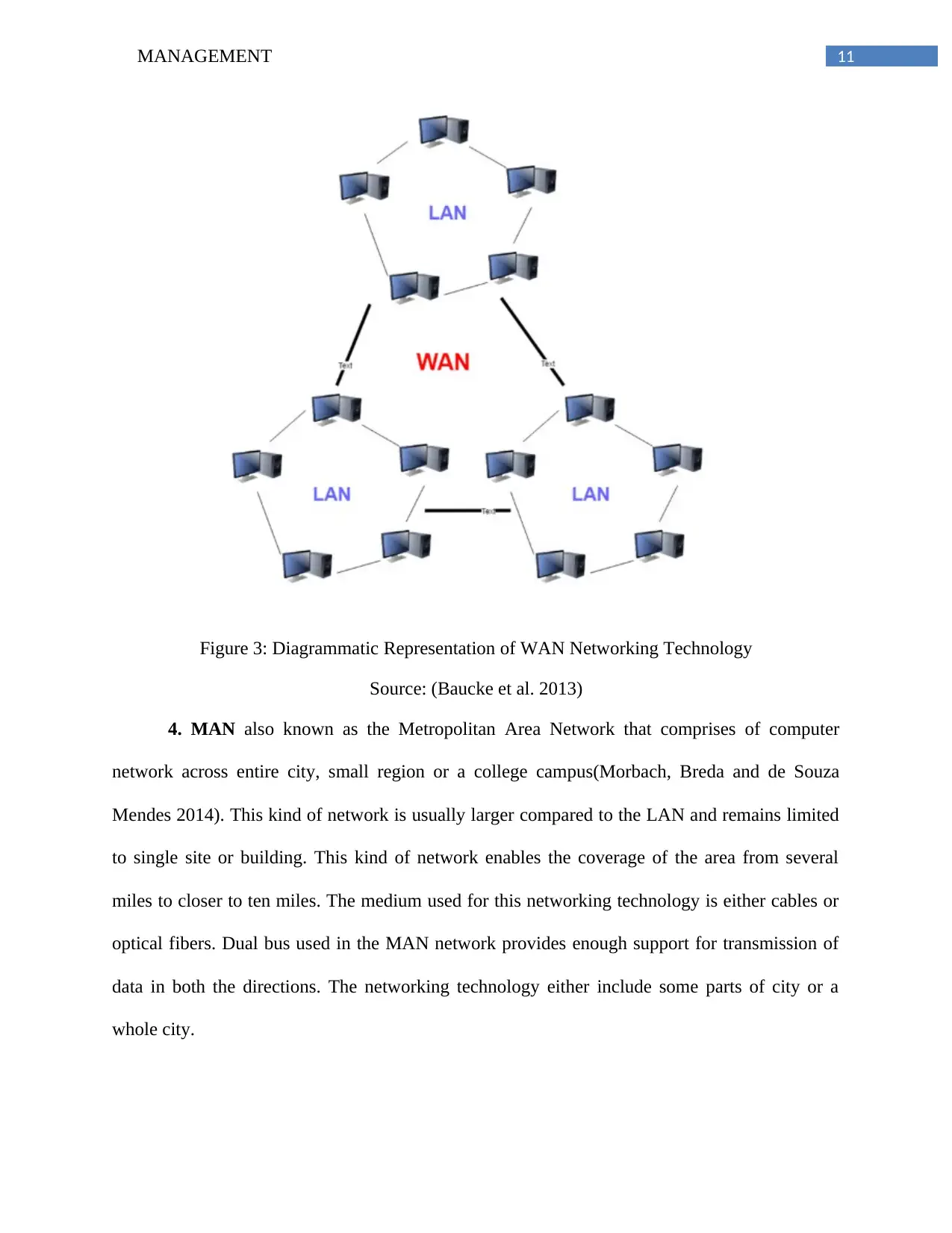
11MANAGEMENT
Figure 3: Diagrammatic Representation of WAN Networking Technology
Source: (Baucke et al. 2013)
4. MAN also known as the Metropolitan Area Network that comprises of computer
network across entire city, small region or a college campus(Morbach, Breda and de Souza
Mendes 2014). This kind of network is usually larger compared to the LAN and remains limited
to single site or building. This kind of network enables the coverage of the area from several
miles to closer to ten miles. The medium used for this networking technology is either cables or
optical fibers. Dual bus used in the MAN network provides enough support for transmission of
data in both the directions. The networking technology either include some parts of city or a
whole city.
Figure 3: Diagrammatic Representation of WAN Networking Technology
Source: (Baucke et al. 2013)
4. MAN also known as the Metropolitan Area Network that comprises of computer
network across entire city, small region or a college campus(Morbach, Breda and de Souza
Mendes 2014). This kind of network is usually larger compared to the LAN and remains limited
to single site or building. This kind of network enables the coverage of the area from several
miles to closer to ten miles. The medium used for this networking technology is either cables or
optical fibers. Dual bus used in the MAN network provides enough support for transmission of
data in both the directions. The networking technology either include some parts of city or a
whole city.
⊘ This is a preview!⊘
Do you want full access?
Subscribe today to unlock all pages.

Trusted by 1+ million students worldwide
1 out of 20
Related Documents
Your All-in-One AI-Powered Toolkit for Academic Success.
+13062052269
info@desklib.com
Available 24*7 on WhatsApp / Email
![[object Object]](/_next/static/media/star-bottom.7253800d.svg)
Unlock your academic potential
Copyright © 2020–2025 A2Z Services. All Rights Reserved. Developed and managed by ZUCOL.





